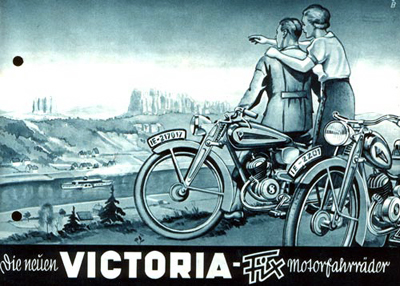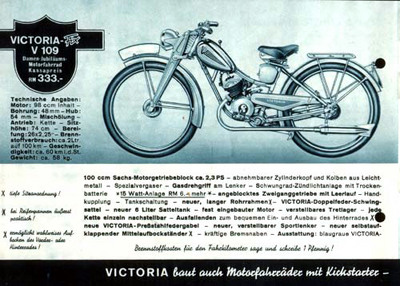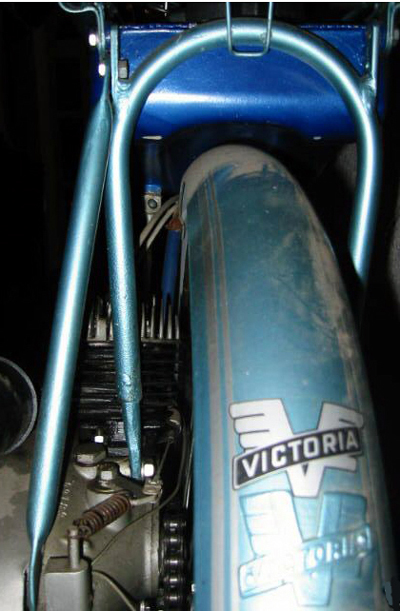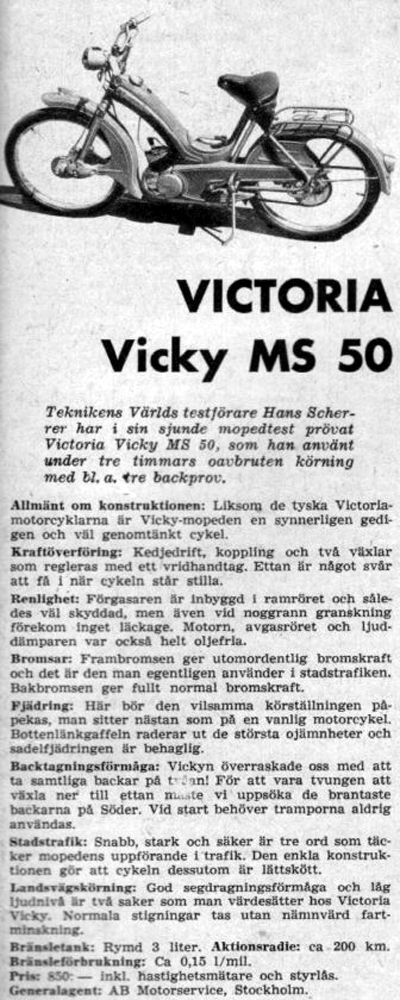PAGE 43. German Cyclemotors: Victoria History & FM 38 Vicky
Victoria FM 38 Vicky Hilfsmotor
The 38cc Victoria FM 38 cycle-attachment engine (‘hilfsmotor’ in German) was made between 1946 and 1954.
The company started, like most motorcycle manufacturers, with bicycles. Founders Max Frankenstein Burger and Max Ottenstein started their company ‘Frankenstein Burger and Ottenstein Nuremberg’ in Nuremberg, in 1886. By 1888 they had manufactured 1000 Victoria bicycles. In 1895 ‘ the name became Victoria Fahrradwerke AG,’ abbreviated to ‘Victoria Werke AG’ in 1899 and they made their first motorcycles in 1901, using Cudel and Fafnir engines.
Their forays into car production were not very successful; but sales of small motorcycles and bicycles were consistent. After World War 1, motorcycle production resumed (1920) and their larger motorcycles became very popular. Their successful 1921 model had a 494cc 2-cylinder sidevalve BMW engine. They introduced their own engine in 1923, a 2-cylinder ohv 497cc flat engine (subsequently increased to 597cc).
Victoria achieved many racing successes in the 1920s and early 1930s. In 1937, like many other manufacturers, they also made some lightweight motorcycles with Fichtel & Sachs engines (below).
These popular small motorcycles with 98cc engines could be considered the fore-runners of the postwar cyclemotors and mopeds. The equivalent in Britain were known ‘autocycles’ and, in France, ‘BMA’ (Bicyclette Moteur Auxiliaire). In Britain most of them were Villiers-powered, while Fichtel & Sachs provided the engines in Germany.
I’ll produce a separate page for Fichtel & Sachs cyclemotors in due course; but for now, after that extremely brief resume of Victoria’s origins, let’s return to their cycle-attachments…
The FM 38 was a very popular unit, with a total production run of 40,000.
It was one of the first postwar cycle-attachments to be made in Europe: although Velosolex had also started production in 1946 in France, Great Britain was several years behind.
Most German factories had, of course, been destroyed in the War. Motorcycles over 350cc were now prohibited by the Allies, and the manufacture of only 10,000 machines with engines between 60cc – 350cc were allowed. There was obviously a major motivation to start tooling up for cyclemotors and getting them out of the factories.
Albert Roder was the chief designer at Victoria (he later achieved worldwide renown for his work at NSU). The FM 38 (Fahrrad-Motor 38cc) was the first cycle-attachment to arrive on the market, did very well in road tests, and was a reliable machine.
The famous picture above is of George Dotterweich’s world record, racing the Victoria FM 38 on the Ingolstadt-Munich highway to achieve 79 kmh.
The rear-mounted design was an interesting innovation at that time; it was a useful solution to the age-old problem of cycle-attachment engines – ie the extra strain they put upon an ordinary bicycle when mounted at the front or in the centre.
Although the vast majority of FM 38’s were sold as a kit to mount onto the purchaser’s own bicycle, some were also sold as a complete unit already mounted onto a Victoria cycle frame.
My Victoria, shown here, is one of those latter versions, an engine mounted onto a Victoria Ladies bicycle (the same model as the one in the Victoria poster)
It’s surprising how unusual it is these days to find an FM 38 in an original frame.
By the way, although pre-war German bicycles were made as separate Gents and Ladies models, similar to British ones (see the pre-war Victoria bicycle advert below) most postwar German cycles were of a ‘unisex’ design such as this Victoria.
******************************************************************
Victoria Vicky Mopeds
******************************************************************
1955 Victoria Vicky III
I now have a Vicky III. To read about it on page 123 of www.BuyVintage.co.uk PLEASE CLICK HERE
******************************************************************
I no longer own the Victoria FM38 pictured above, but I do have a 1949 Victoria herrenrad, to which I’ve now fitted (with some difficulty!) a Nordap cyclemotor in the front wheel.
To see pictures of it at the Online Bicyle Museum PLEASE CLICK HERE

******************************************************************
1954 Rex Vicoped
Vicoped and Zundapped
******************************************************************
1955 Victoria Nicky Scooter
Like most manufacturers, Victoria also tried their hand at building scooters.
The 1955 Nicky was a well-built and attractive machine. However, Germany produced some superb scooters in the 1950s, and the Nicky did not compete well against them.
This Nicky scooter appeared on UK ebay, missing only the seat and a small part of the near-side legshield. It did not sell. The registration shows that it was first registered in Great Britain in 1955, in Devon.
I did make an offer for it, but so far without success.
******************************************************************
The Spatz Victoria Sparrow
In 1954 Egon Brütsch designed the first German car with a fibreglass shell (a 3-wheeler, called the ‘Type 200’ or ‘Spatz’ pictured above). But he had difficulties constructing it and so he sold the design to Harald Friedrich of toolmakers Alzmetall.
Hans Ledwinka, of the Czech company Tatra, was commissioned to improve its design.
Ledwinka was by now out of favour with the communists (he’d been detained) and he left the Eastern Bloc for Munich. He redesigned the chassis as a 4-wheeler (above and below) with a fixed central backbone tube and the front wheels hung on a separate subframe. It now also had strut suspension and hydraulic brakes. The twin rear wheels were on swing axles, and the Plexiglas windshield was replaced by a split glass one. The Spatz used the 200cc Sachs engine (as in the Messerschmitt).
Because they lacked a dealer network, they did a deal with Victoria. Victoria Werke in Nurnberg handled sales, distribution and service.
It made its debut at the IAA in 1955 in Frankfurt, but the car was not well-received. Its price was high and did not perform well. It was easily flammable. There were some problems with the engine. And Brutsch, meanwhile, was critical of the ‘corruption’ of his original design, and launched a lawsuit.
So Friedrich handed over the rights to the vehicle to Victoria, in 1956, who replaced the engine with one of their own, a 250cc. 859 cars were built in total, until production ended in 1957. The 1957 Victoria Spatz Sparrow is pictured above.
******************************************************************



































You must be logged in to post a comment.